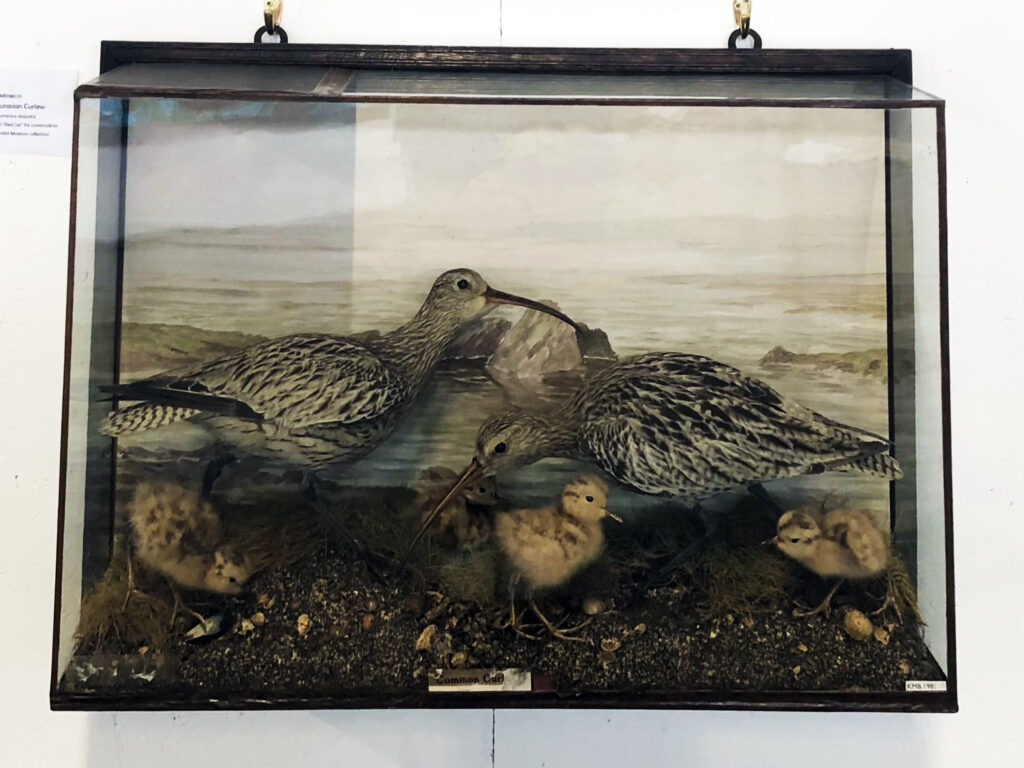This wonderful bird is the focus of our summer exhibition the ‘Cry of the Curlew’.
Curlews
There are eight different species of curlew!

Two male adult Eurasian curlews and four chicks assembled by taxidermists. Currently on display at the ‘Cry of the Curlew’ exhibition at Kendal Museum.
The Eurasian curlew, pictured above, has the most widespread population and can be found across South Asia, Europe, and Africa.
Eurasian Curlew
The Eurasian Curlew, known by its scientific name Numenius arquata, is the largest European wading bird with an impressive wingspan of 90cm. Its long, down-curved bill, brown upperpart and long legs make it instantly recognisable.
The Eurasian curlew is known by many names across Europe and is most popularly referred to as simply the ‘curlew’.
In Germany the curlew is known as the brachvogel (meadow bird), named for where they make their nests. In Welsh they are known as y gylfinir: gylfin meaning bill and hir meaning long!
The English name derives from the eerie ‘cur-lee’ call of the curlew, which can be heard along coasts and estuaries in winter and on meadows, pastures, and moors during the summer. The cry of the curlew is immortalised in the Old English poem, The Seafarer, which dates to around 1000 CE.
”I take my gladness in the… sound of the curlew instead of the laughter of men”.
The Seafarer
Behaviour and Habitat
Curlews are migratory birds. In the winter our local curlews can be found on the coast where they are joined by large numbers of Scandinavian-breeding curlews, taking advantage of the moderately mild UK winters.
In the summer they migrate to their breeding grounds in the insect-rich upland areas of meadow, moorland, and wetland. Curlews are scarce as a breeding species in lowland landscapes. The lush grass environment of the uplands of England, Scotland, and Wales – including Kendal itself – makes an ideal breeding habitat for the curlew.
They lay their eggs in a nest on the ground, known as a scrape, hidden by long grass. Both parents incubate their eggs for a period of about four weeks before they hatch. After this period, the young stick close to their parents for a further four weeks until they are ready to fledge.
Curlews reach breeding age at two years old and live for around five to ten years. Although the oldest recorded age of a curlew was 32 years old! They have a diet of insects, worms, shellfish, and shrimp. Their long sensitive downcurved bill acts as a tweezer and helps them find their prey in the mud.
Threats
The curlew is included on the Red list of UK Birds of Conservation Concern. Their population has declined by 50% in the last twenty-five years, with only fifty-nine thousand breeding pairs left in the UK.
One cause of this is the loss of curlew habitat. Many of the meadows used as curlew breeding grounds have now been drained, fertilised, and turned into cereal fields or fast-growing grasses for animal feed.
The loss of meadows is widespread across Europe as the demand for milk and meat has grown.
Due to the fact that curlews nest on the ground, their eggs and chicks are also vulnerable to predators. These predators include foxes and crows, whose populations have only steadily increased in the last few decades.
Curlew Conservation
There are several groups working to raise awareness of curlew conservation and actively working towards securing a better future for the species.
Curlews typically nest between March and July, meaning we need to be extra careful during this time to protect their ground nests. In addition to being susceptible to predators, curlew nests are vulnerable to disturbance from walkers, cyclists, and curious dogs.
Please keep dogs on leads and stick to the footpath to minimise the risk of disturbing their nests.
You can find out more about the curlew conservation by visiting the ‘Cry of the Curlew Exhibition’ at Kendal Museum!
References
British Trust for Ornithology – Curlew

